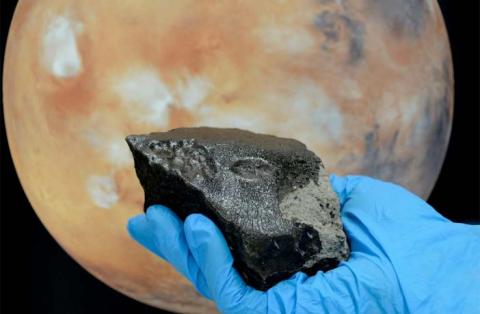OU researchers discover ancient water reservoirs inside Mars

A team of researchers, including scientists from The Open University (OU), have discovered ancient water reservoirs inside the mantle of Mars.
OU researchers Professor Mahesh Anand, Dr Ian Franchi, Dr Susanne Schwenzer and Dr Jessica Barnes, a former student at the OU and an Assistant Professor at the University of Arizona, worked as part of a wider team to make the discovery.
Mars’ mantle contains multiple reservoirs
Research findings show that Mars’ mantle may contain multiple distinct reservoirs of mineral-bound water preserved from the planet’s early history, which suggests that the Martian mantle has a diverse chemical composition and might not have been formed from a global magma ocean.
Mahesh Anand, Professor of Planetary Science and Exploration at The Open University, said:
“The findings from this study have important implications for our understanding of the geological history of water in the inner Solar System and the formation and differentiation histories of rocky planets, especially in a star’s habitable zone.”
The isotopic composition of hydrogen on Mars provides insights into different water reservoirs on the planet. Existing models of Mars’ formation have assumed that the mantle has a homogenous hydrogen isotope composition. However, the varied isotopic compositions of Martian rocks and the Martian atmosphere have complicated these models and the identification of distinct water reservoirs in and on Mars.
Meteorites lead to new discovery
The team led by Dr Barnes, a former PhD student and a postdoctoral researcher at the OU where this work began, analysed the hydrogen isotope composition of minerals from two meteorites from Mars’ crust, where the meteorites interacted with water around 1.5 and 3.9 billion years ago.
Researchers found that the two meteorites have a similar hydrogen isotope composition. This composition is also similar to more recent material from the planet’s crust, indicating that the composition of water has been consistent for the past 3.9 billion years.
Researchers compared this to data from other Martian meteorites and found that Mars’ mantle contains at least two reservoirs of mineral-bound water that have distinct hydrogen isotope compositions.
Findings, published today in Nature Geoscience, suggest that the differing composition of these reservoirs indicates that Mars may not have been homogenized by a global magma ocean after it formed, as previous research suggested.
Dr Barnes, Assistant Professor at the University of Arizona, comments:
“These two different sources of water in Mars’ interior might be telling us something about the kinds of objects that were available to be accreted into the inner, rocky planets. This context is also important for understanding the past habitability and astrobiology of Mars.”
The work at the Open University was partially supported through a Science and Technology Facilities Council (STFC) research grant awarded to Professor Mahesh Anand and Dr Ian Franchi.
Image: Martian meteorite NWA 7034, also known as Black Beauty, and Mars (Credit: Natural History Museum, London).
Article from here, written by Bridgette Honegan.
.jpg)
